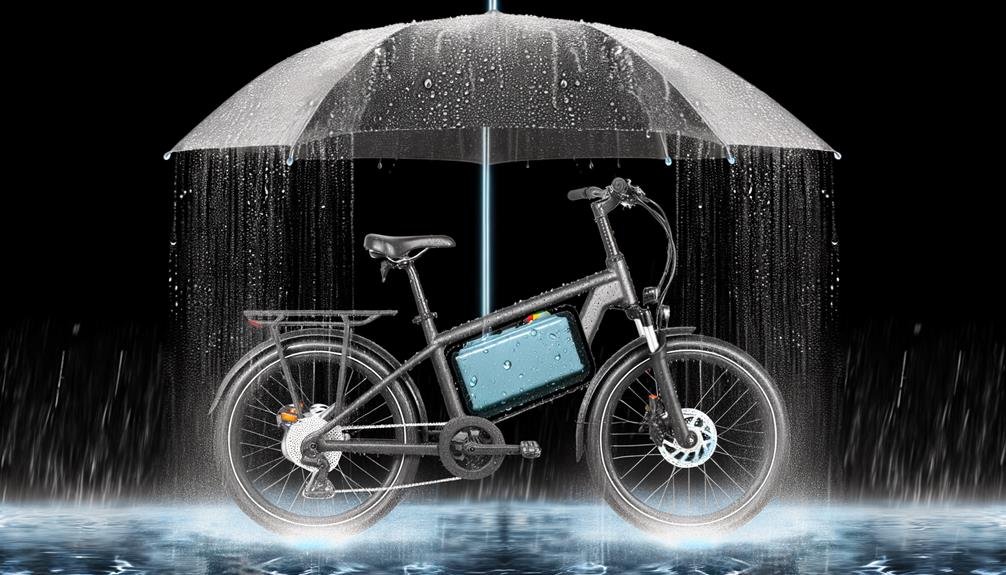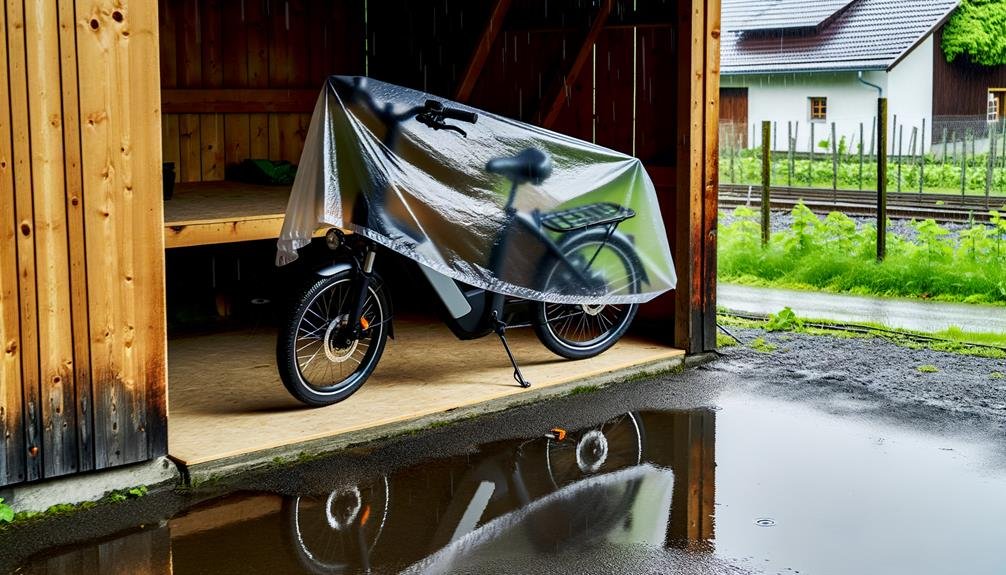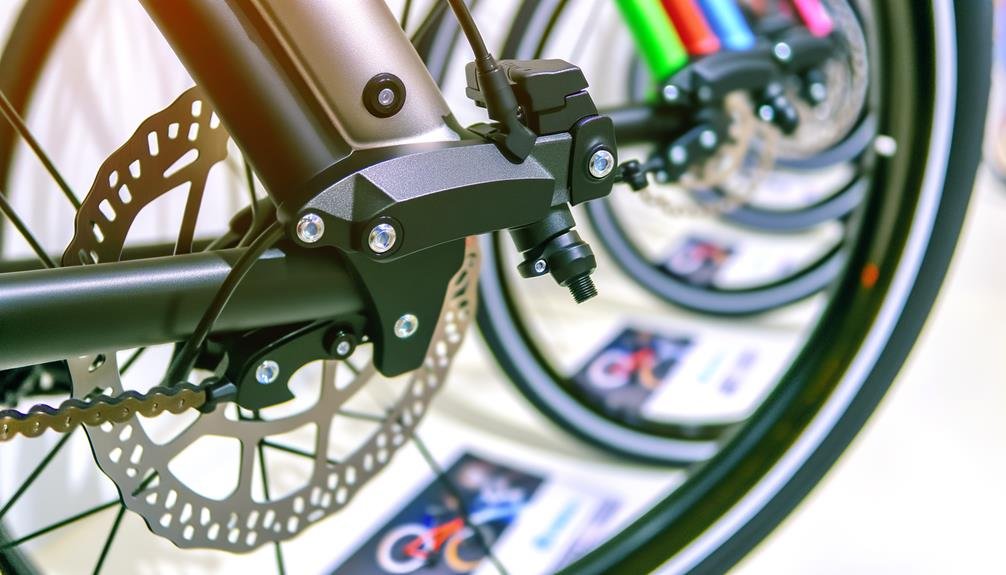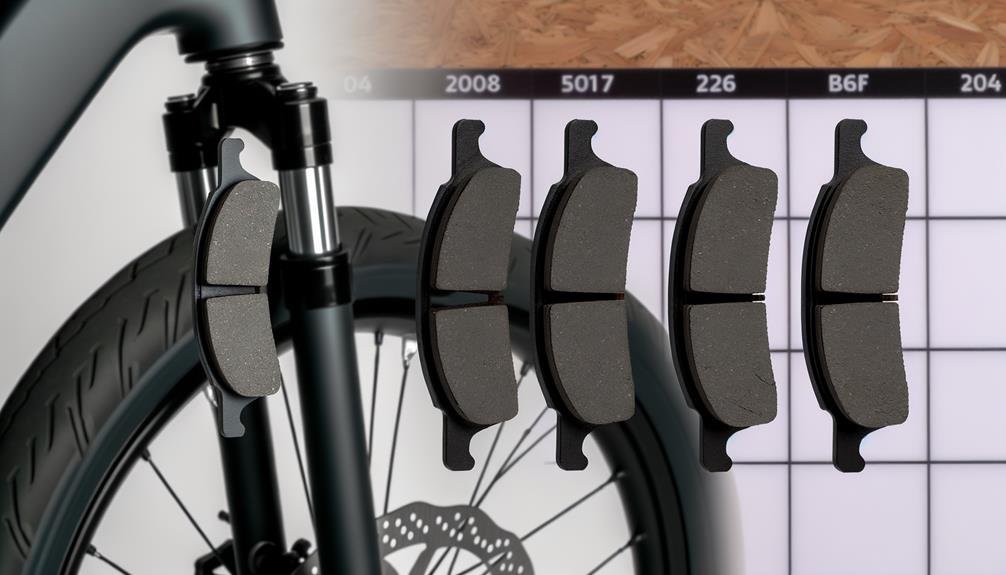Charles Miller is a veteran bike enthusiast with over 12 years of experience dealing with bikes as a mechanic. Despite immense love and expertise for...
As the old saying goes, you can't control the weather, but you can certainly prepare for it. When it comes to using an electric bike in the rain, there's a lot to consider.
Are these bikes designed to handle the rain? What precautions should we take to protect our e-bikes from potential water damage? And what about the safety aspect of riding in wet conditions?
Stay tuned as we navigate through these questions, providing insights and advice that will help you brave the elements with confidence on your e-bike.
- Key Takeaways
- Understanding E-bike Rainproof Features
- Precautions Before Riding in Rain
- Essential Gear for Wet Conditions
- Cleaning and Maintenance After Rainy Rides
- Safeguarding Your E-bike's Battery
- Recognizing Rain-Related Damage
- Assessing Your E-bike's IP Rating
- Avoiding Hazardous Rainy Situations
- E-bike Storage During Wet Seasons
- Frequently Asked Questions
- Conclusion
Key Takeaways
- E-bikes with high IP ratings are designed to withstand water damage, making them suitable for riding in the rain.
- Taking precautions such as using waterproof panniers or silicone bags can help protect valuables from getting wet.
- It is important to avoid submerging the motor and battery in deep water and to turn off the power before doing so.
- Proper post-rain care, including cleaning and drying the e-bike thoroughly, inspecting for any damage, and taking preventive measures to protect the battery and display, is essential for maintaining the longevity of the e-bike.
Understanding E-bike Rainproof Features
When it comes to safeguarding your e-bike from the elements, especially rain, understanding its rainproof features can make a significant difference. Understanding e-bike rainproof features isn't just about knowing how to protect your ebike in the rain, it's about making sure you're part of a community that values longevity and durability in their rides.
Our first point of focus is Ingress Protection or IP rating, a standard that defines how resistant an e-bike is to foreign elements like dust and water. When you're out in the rain, having a high IP rating means your e-bike has a solid level of protection against the water, ensuring that vital components are safe from potential damage.
Equally important are waterproof panniers or silicone bags. They're excellent for protecting your valuables and keeping them dry. Battery plates and pin covers are also crucial, offering additional protection when your battery is removed and stored. Moreover, fenders prevent water or mud from splashing onto you or your e-bike, and bespoke covers or homemade ones from neoprene with velcro can provide added protection for your battery and display.
And of course, proper rain gear, including good-quality tires and functioning brakes, are a must. This kind of understanding can make your ebike a trusty companion, rain or shine.
Precautions Before Riding in Rain
Before we hit the road in the rain on our e-bikes, there are several precautions we need to take into account.
Firstly, we'll be looking at how to waterproof our e-bikes to prevent damage to the motor and battery.
Then, we'll consider the essential gear required for a safe and comfortable ride.
Waterproofing Your E-Bike
To effectively waterproof our e-bike for those rainy days, it's crucial to avoid riding through deep water that could potentially submerge the motor and battery. Keeping water away from these critical components is essential for the longevity of electric bikes.
When it comes to waterproofing your e-bike, we recommend the following steps:
- Always turn off the power before walking or riding through deep water.
- Make sure the motor and battery are completely dry before turning the power back on.
- Protect your battery and display when traveling in the rain.
- After riding in the rain, clean and re-lube your chain and drivetrain.
Proper Riding Gear
Equipping yourself with the right gear is a crucial step we can't overlook for safe riding in the rain. This includes bright lights, high visibility clothing, a sturdy helmet, and clear glasses or goggles. Proper rain gear is essential when preparing for a rainy day e-bike ride. Lowering your tire pressures for better traction and using mudguards to stay clean are also important. Waterproof panniers are a smart investment, and we recommend using ziplock or silicone bags to protect your valuables. Lastly, a helmet visor can be a game changer, keeping water out of your eyes and enhancing visibility while riding your e-bike. This way, we ensure not just enjoyable, but also safe e-bike rides, regardless of the weather.
Post-Rain Care Tips
Having established the necessity of proper riding gear, we now turn our attention to vital post-rain care tips and precautions you should take before venturing out on a wet ride. We're all part of the ebike community, so let's keep our bikes in top shape.
- Clean Your Bike: It's essential to clean your ebike after riding in the rain. Visit a bike shop if necessary for a thorough cleanup.
- Dry it Properly: Don't leave your ebike dripping wet. Ensure it's completely dry before your next ride.
- Check for Damage: Inspect your bike carefully. Rain can cause unexpected wear and tear.
- Battery Care: Clean and dry the battery contact points to prevent corrosion.
Essential Gear for Wet Conditions
When we venture out on our electric bikes in wet conditions, it's crucial to prioritize safety and performance by using gear such as lights, high-vis clothing, helmets, and clear glasses or goggles. This essential gear for wet conditions ensures we remain visible to other road users and keeps us protected from potential hazards.
Remember to lower your tire pressures for better traction, and don't forget the mudguards to keep you and your E-bike clean. After riding in wet conditions, promptly clean and re-lube your chain and drivetrain to avoid rust and maintain performance.
For those long journeys, waterproof panniers are a must to keep your belongings dry. Protect your E-bike's battery and display with covers, and be wary of deep puddles and potholes that may damage the electric components.
Lastly, change your riding style. Slow down, brake early and smoothly, and avoid leaning into corners. It's not just about having the right gear, but also knowing how to ride an E-bike in wet conditions. By following these guidelines, we can safely enjoy and extend the life of our electric bikes, regardless of the weather.
Cleaning and Maintenance After Rainy Rides

Beyond adapting our riding style and gear for rainy conditions, it's equally vital to give our e-bikes the proper post-ride care they require to maintain optimal performance and longevity. This goes doubly so when we've opted to ride in the rain. Wet weather can take a toll on our e-bikes, especially if they're not adequately cleaned and maintained after rainy rides.
To ensure your e-bike continues to function optimally, we recommend the following steps:
- Wipe down the e-bike to remove any moisture and dirt.
- Clean and lubricate the bike chain to prevent rust.
- Inspect and clean the battery contact points.
- Use a leaf blower to dry hard-to-reach areas.
These steps aren't just about keeping our e-bikes looking good – they're about ensuring that we can rely on them for many wet weather rides to come. Don't risk the longevity and performance of your e-bike. Instead, take these simple steps after every ride in the rain. Your e-bike – and your future self – will thank you.
Safeguarding Your E-bike's Battery
Protecting your e-bike's battery, the heart of the machine, from the ravages of rain is a crucial aspect of e-bike maintenance and longevity. When riding an e-bike in adverse weather, it's vital to avoid submerging the motor and battery in deep water. These components are sensitive and exposure to water can lead to significant damage.
After a rainy ride, we recommend cleaning and drying your e-bike quickly to prevent moisture-related issues. Pay particular attention to the battery contact points. A contact cleaner can be used to ensure these points remain free of moisture and dirt, maintaining proper functionality.
Of course, safeguarding your e-bike's battery isn't just about post-ride maintenance. It also involves taking preventive measures. Using bespoke covers or neoprene with velcro can provide a strong line of defense for the battery and display when you're on the go.
Recognizing Rain-Related Damage

It's essential for us to understand the effects of weather, particularly rain, on our electric bikes. Spotting water damage early can prevent more serious issues down the line.
Let's discuss how to identify these signs and share some preventive maintenance tips to help keep your e-bike in optimal condition.
Understanding Weather Effects
When navigating wet conditions on an electric bike, we need to understand the potential for rain-related damage and take preventive measures. Rain can affect various parts of your electric bike, and understanding weather effects is crucial to ensure the longevity of your ride.
To safeguard your electric bike while riding in the rain, consider these steps:
- Avoid submerging your motor and battery in water.
- After a wet ride, clean and re-lube your chain and drivetrain to prevent corrosion.
- Use mudguards and fenders to keep your bike clean.
- Protect your battery and display with covers or neoprene with velcro.
Spotting Water Damage
Keeping an eye out for rain-related damage is essential for maintaining the health of your electric bike. There are several key indicators of water damage to look for.
Spotting water damage can start with noticing water stains, specifically on the motor or battery. Rust or corrosion on chain, bolts, and spokes is another telltale sign. The brake pads can also suffer, so inspect them for excessive wear.
The display screen's fogging or water intrusion is a clear indicator of damage. Moreover, if your bike's been submerged in water, watch out for unusual sounds or behaviors from the electrical components.
Together, we can keep our e-bikes in top shape, even in wet weather.
Preventive Maintenance Tips
To ensure our e-bikes remain in pristine condition despite rain exposure, we've outlined several preventive maintenance tips to recognize and address rain-related damage.
As part of this community, it's important we keep our rides in top-notch condition. So, here are some points to consider:
- After a rainy ride, make sure you check, clean, and re-lube your chain and drivetrain. This prevents corrosion and damage.
- Regularly inspect electric components for signs of water damage, such as rust or electrical issues.
- Protect your motor and battery from the elements using covers or a DIY neoprene wrap with velcro.
- Clean the battery contact points with a contact cleaner and ensure your e-bike is completely dry before reattaching the battery.
Together, we can ensure our e-bikes last through even the rainiest of seasons.
Assessing Your E-bike's IP Rating

Before heading out in the rain, it's essential to check your e-bike's IP rating on the manufacturer's website, ensuring it's 66 or higher for safe riding in permanent rain.
IP, or Ingress Protection, rating is a critical factor when assessing your e-bike's ability to withstand moisture. This rating specifically gauges the electric bike's resilience against dust and water, vital in safeguarding motors and batteries from damage.
E-bikes with an IP rating less than 55 aren't suitable for consistent rain exposure. Such conditions could compromise the electrical components, leading to performance issues or total failure. If you're caught in a downpour, consider protecting your battery and display with bespoke covers or DIY solutions like neoprene with velcro.
When gauging the force of rain, remember it's more intense while moving or behind a car, so take extra precautions for longer trips. Also, be mindful of road conditions, as white lines, metal tracks, and potholes become more hazardous when wet.
Ultimately, the IP rating is a critical consideration in the electric bike's rain resilience. It's essential to assess this before venturing into the rain to ensure a safe and enjoyable ride.
Avoiding Hazardous Rainy Situations
Having examined the importance of understanding your e-bike's IP rating for wet conditions, we now shift our attention to the practical strategies for avoiding hazardous situations when riding in the rain. When it comes to riding your bike in the rain, it's critical to maintain safety as the top priority. Slippery surfaces and deep water can pose serious threats, and we must be equipped to handle them effectively.
Here are some key strategies to help you avoid hazardous rainy situations:
- Avoid riding through water that could submerge your motor and battery.
- Be cautious not to leave your e-bike in water as it can cause damage.
- If you have to ride through deep water, make sure to turn off your electrics. Don't turn the power back on until your e-bike is completely dry.
- Pay attention to road conditions. Be particularly wary of white lines, metal tracks, potholes, and other slippery surfaces.
E-bike Storage During Wet Seasons

When it comes to storing your e-bike during wet seasons, it's crucial to remember that proper indoor storage can prevent degradation and potential damage to the bike's components. Ensuring your e-bike is kept indoors not only shields it from the elements but also maintains its efficient performance.
If indoor storage isn't feasible, we recommend using waterproof bike covers. These can provide an extra layer of protection against the rain. However, don't forget to dry your e-bike thoroughly before riding it again. Moisture left on the bike can lead to potential damage and may affect its safe operation.
Even if you ride my e-bike in the rain, make sure to properly dry it off afterward. This will prevent moisture-related issues and keep your e-bike in top shape. Regularly wiping down your e-bike can also help remove any excess wetness and maintain its condition and performance.
Frequently Asked Questions
What Happens if an Electric Bike Gets Wet?
When our electric bike gets wet, it can impact its performance if we're not careful. We'll need to perform maintenance such as drying, cleaning, and re-lubing to prevent any long-term damage.
Are Electric Bikes Waterproof?
Sure, they're "waterproof", but that doesn't mean we can submerge 'em. Let's consider maintenance tips, assess impacts, follow charging safety, and explore storage solutions. Our e-bikes can handle a sprinkle, not an underwater adventure.
How Do I Protect My Ebike Battery From Rain?
To protect our e-bike battery from rain, we're using rainproof covers and performing regular maintenance. This ensures charging safety and extends our battery's lifespan. It's our responsibility to keep our e-bike functioning optimally.
What Should You Not Do on a Electric Bike?
We shouldn't neglect braking considerations, speed adjustments, and maintenance practices on an electric bike. Also, it's important we don't ignore safety gear; it's our first defense in case of an accident.
Conclusion
In conclusion, we've seen that it's not only possible, but also manageable to use an e-bike in the rain. After all, isn't an e-bike's versatility part of its allure?
With careful precautions, suitable gear, and meticulous maintenance, we can extend the life and efficiency of our e-bikes, even in wet conditions. Let's make sure we understand our e-bike's specific features and limitations, avoiding hazardous situations and ensuring optimal storage during rainy seasons.

Charles Miller is a veteran bike enthusiast with over 12 years of experience dealing with bikes as a mechanic. Despite immense love and expertise for his Tacoma, he rides his Trek Ebike more. Anytime you meet him, you’ll either hear him talking about Bikes, or writing about all things bikes and cars on this blog.
More Posts


